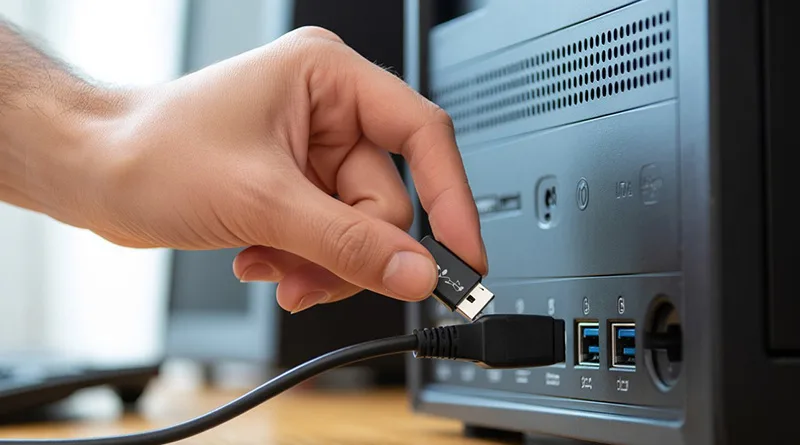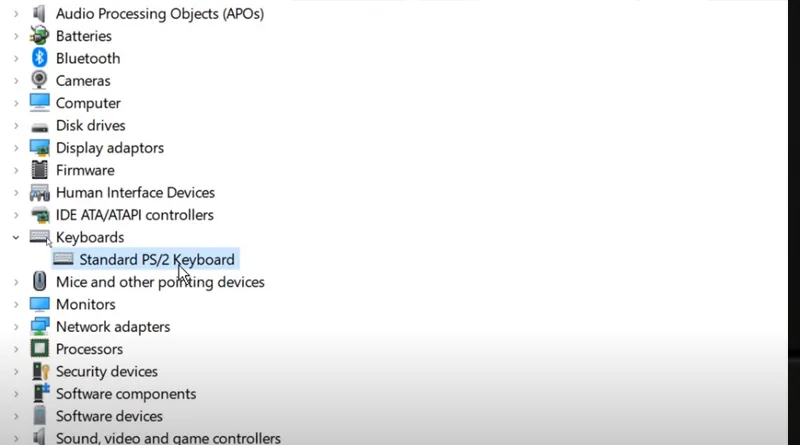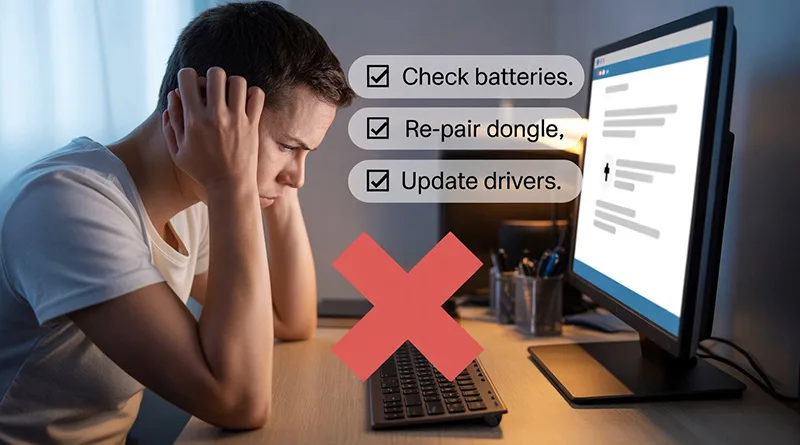There are few tech problems more frustrating than when your wireless keyboard not working. One moment you’re typing away, and the next, you’re met with a dead, unresponsive device. It’s an issue that can bring your productivity or your gaming session to a screeching halt. Whether you’re using a brand new keyboard or a trusty old companion, connection issues can happen to anyone.
The good news is that in the vast majority of cases, the problem is simple and very easy to fix. Before you start shopping for a replacement, there are a series of quick troubleshooting steps you can take that will solve the issue 99% of the time.
This guide will walk you through 7 easy fixes for when your wireless keyboard not working, starting with the most common and simple solutions.
Before You Begin: The Most Common Culprit
Let’s get the most obvious but surprisingly common issue that causes a wireless keyboard not working out of the way first: check the power.
- Is the Keyboard Turned On? Many wireless keyboards have a small physical on/off switch on the back or side. It’s incredibly easy to accidentally bump this switch. Make sure it’s firmly in the “On” position.
- Check the Batteries: If your keyboard uses replaceable batteries (AA or AAA), they may simply be dead. Try swapping in a fresh set. If your keyboard is rechargeable, plug it directly into your PC or a wall adapter with a USB-C or Micro-USB cable and let it charge for at least 30 minutes before trying again.
If you’ve confirmed the keyboard has power and you find your wireless keyboard not working still, it’s time to move on to the more technical fixes.
What to Do When Your Wireless Keyboard Not Working: 7 Fixes
Work through these steps in order.
Fix 1: Re-Pair the 2.4GHz USB Dongle
If your keyboard uses a 2.4GHz USB dongle, the connection between the keyboard and the dongle can sometimes be lost. The solution is to re-establish this connection.
- Unplug the USB dongle from your computer.
- Turn your keyboard off using its physical switch.
- Wait about 10 seconds. This allows both devices to fully power down.
- Plug the USB dongle back into your computer. It’s best to use a different USB port than the one it was in before, just in case the port itself is the issue.
- Turn your keyboard back on. In most cases, the keyboard and dongle will automatically find each other and re-pair within a few seconds.
Fix 2: Troubleshoot a Bluetooth Connection
If your keyboard connects via Bluetooth, the process is slightly different.
- Go to Settings > Bluetooth & devices on your Windows PC (or the equivalent on a Mac).
- Find your keyboard in the list of paired devices.
- Click the three dots next to its name and select “Remove device.”
- Now, put your keyboard back into pairing mode. There is usually a dedicated Bluetooth button on the keyboard you need to press and hold for 3-5 seconds until a light starts flashing.
- On your PC, click “Add device” and select your keyboard from the list to re-pair it.
Fix 3: Rule Out USB Port Issues
Sometimes, the keyboard is fine, but the USB port it’s plugged into is the problem.

- Try a Different Port: If your wireless keyboard not working is a persistent issue, unplug the 2.4GHz dongle and plug it into a different USB port on your computer.
- Avoid USB Hubs: If you have your dongle plugged into a USB hub or an extension cable, try plugging it directly into one of the main USB ports on the front or back of your PC. A weak or unpowered hub can often cause connection issues.
Fix 4: Update or Reinstall Keyboard Drivers
A corrupt driver can cause your keyboard to stop being recognized by your operating system.
- Right-click the Start button and select “Device Manager.”
- Expand the “Keyboards” section.
- Right-click on your wireless keyboard’s name.
- First, select “Update driver” and let Windows search automatically.
- If that doesn’t work, right-click it again and select “Uninstall device.”
- Once it’s uninstalled, unplug and replug your USB dongle. Windows will automatically detect it and reinstall the correct driver.

For a more detailed, step-by-step visual guide on managing drivers, the official Microsoft Support page for Windows is an excellent and authoritative resource.
Fix 5: Run the Windows Hardware Troubleshooter
Windows has a built-in tool designed to find and fix common hardware problems, and it’s a great step to take when your wireless keyboard not working.
- Go to Settings > System > Troubleshoot > Other troubleshooters.
- Find “Keyboard” in the list and click the “Run” button next to it.
- Follow the on-screen prompts and let the troubleshooter attempt to diagnose and fix the issue.
Fix 6: Check for Signal Interference
Wireless devices can be affected by interference from other electronics.
- Move the Dongle Closer: If your PC is under your desk, the signal might be weak. Try moving the 2.4GHz dongle to a front USB port to get a clearer line of sight to the keyboard.
- Remove Obstructions: Large metal objects or other powerful wireless devices (like a Wi-Fi router) placed between your keyboard and the receiver can interfere with the signal. Try to keep the path between them as clear as possible.
Fix 7: Test on Another Computer
This is the final and most definitive test to determine why your wireless keyboard not working. Plug your wireless keyboard’s dongle into a different laptop or desktop computer.
- If the keyboard works on the other computer, you know the problem lies with your original PC’s software or USB ports.
- If the keyboard still doesn’t work on a different computer, it’s very likely that the keyboard itself has suffered a hardware failure.
Conclusion: When Is It Time for an Upgrade?
Following these 7 steps will solve the vast majority of issues when a wireless keyboard not working. Most of the time, the problem is a simple power, connection, or driver issue that can be fixed in minutes.
However, if you’ve tried all these fixes, including testing on a separate computer, and the keyboard remains unresponsive, it may unfortunately be time to replace it. Hardware does fail over time. If you’re in the market for a new, reliable model, our guide to the best Logitech wireless keyboards is a great place to start your search for a worthy successor.

